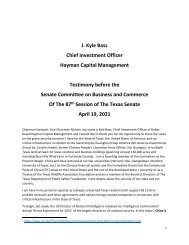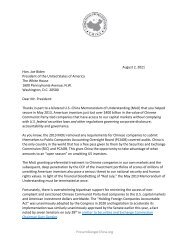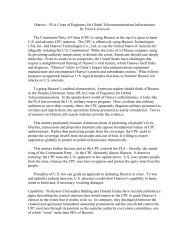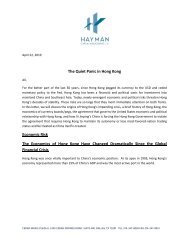You also want an ePaper? Increase the reach of your titles
YUMPU automatically turns print PDFs into web optimized ePapers that Google loves.
<strong>May</strong> <strong>20</strong>, <strong>20</strong>19<br />
<strong>Trouble</strong> <strong>in</strong> <strong>Hong</strong> <strong>Kong</strong> – <strong>Part</strong> <strong>Deux</strong><br />
All,<br />
As a follow‐up to our letter dated April 22, <strong>20</strong>19, we want to address a few critical issues related to <strong>Hong</strong><br />
<strong>Kong</strong>’s reserves. We have heard from the architect of the <strong>Hong</strong> <strong>Kong</strong> Dollar (HKD) peg himself, ivorytower<br />
academics <strong>in</strong> Maryland, journalists, and sell‐side economists s<strong>in</strong>ce the <strong>in</strong>troduction of our thoughts<br />
regard<strong>in</strong>g the reserve plight of the <strong>Hong</strong> <strong>Kong</strong> Monetary Authority (HKMA). The most frequent and basic<br />
response to our thesis has been the follow<strong>in</strong>g: “The HKMA reports approximately $436 billion USD of<br />
foreign currency reserves. This <strong>in</strong>credible pile of dollars would make it foolish to th<strong>in</strong>k that the HKMA<br />
could ever possibly be <strong>in</strong> danger of runn<strong>in</strong>g out of reserves.”<br />
The operative questions that must be answered are:<br />
1. Are <strong>Hong</strong> <strong>Kong</strong>’s FX Reserves adequate as determ<strong>in</strong>ed by the IMF’s Reserve Adequacy<br />
Formalism?<br />
2. How much of the reported $436 billion USD of FX Reserves 1 are actually useable by the HKMA?<br />
The answers to these questions require plung<strong>in</strong>g deep <strong>in</strong>to the rabbit hole of central bank account<strong>in</strong>g and<br />
reserve management. Apologies <strong>in</strong> advance for the technical nature of this note. Unfortunately, this k<strong>in</strong>d<br />
of analysis is required to unmask the broad, misguided (and mislead<strong>in</strong>g) statements be<strong>in</strong>g made regard<strong>in</strong>g<br />
the supposed reserve adequacy of <strong>Hong</strong> <strong>Kong</strong>.<br />
<strong>Hong</strong> <strong>Kong</strong> Doesn’t Meet Basic IMF Reserve Adequacy – The Asset Side of the<br />
Equation<br />
For a currency like the <strong>Hong</strong> <strong>Kong</strong> Dollar (HKD), which is (and has been for 36yrs) effectively pegged to the<br />
United States Dollar (USD), with<strong>in</strong> the 7.7500/7.8500 band, the HKMA uses Foreign Exchange (FX) Reserve<br />
<strong>in</strong>terventions to both ma<strong>in</strong>ta<strong>in</strong> the currency peg and import the United States Federal Reserve’s monetary<br />
policy <strong>in</strong>to <strong>Hong</strong> <strong>Kong</strong>. These <strong>in</strong>terventions change both sides of the HKMA’s balance sheet – i.e.,<br />
ext<strong>in</strong>guish an HKD liability along with the sale of an USD asset at the weak‐side of the band (7.8500) or<br />
create an HKD liability along with the purchase of an USD asset at the strong‐side of the band (7.7500).<br />
For a pegged currency like the HKD, the amount of FX Reserves that are freely available is equivalent to<br />
1<br />
HKMA Foreign Currency Reserve Asset press release on <strong>May</strong> 7, <strong>20</strong>19<br />
CEDAR MAPLE PLAZA II, 2305 CEDAR SPRINGS ROAD, SUITE 400, DALLAS, TX 75<strong>20</strong>1 TEL. 214-347-8050 FAX 214-347-8051
how much the central bank’s balance sheet can be shrunk. The problem with the possibility of<br />
ext<strong>in</strong>guishment is the consequence of do<strong>in</strong>g so. Once the excess reserve (or aggregate balance) is<br />
depleted, additional ext<strong>in</strong>guishments dra<strong>in</strong> precious liquidity from the money supply and <strong>in</strong>crease<br />
<strong>in</strong>terbank and retail <strong>in</strong>terest rates.<br />
Over the past several years the International Monetary Fund (IMF) has conducted extensive research 2<br />
<strong>in</strong>to the adequacy of central bank FX Reserves to prevent or hold off balance of payment and currency<br />
crises. The IMF’s conclusions have been published <strong>in</strong> a series of reports. They identify primary factors<br />
related to trade, bank<strong>in</strong>g system, and cross‐border f<strong>in</strong>ancial claims, which can lead to capital outflows <strong>in</strong><br />
a stressed environment and therefore necessitate a m<strong>in</strong>imum level of FX Reserves 3 .<br />
We have calculated the m<strong>in</strong>imum reserve requirement for <strong>Hong</strong> <strong>Kong</strong> as per the below IMF’s formula:<br />
IMF M<strong>in</strong>imum FX Reserves = 10%*Exports + 10%*Broad Money Supply + <strong>20</strong>%*Other Portfolio<br />
Liabilities + 30%*Short Term Debt<br />
A straight‐forward evaluation of this equation <strong>in</strong>dicates a m<strong>in</strong>imum reserve requirement for <strong>Hong</strong> <strong>Kong</strong><br />
of (10%*$684b) 4 + (10%*$1,828b) 5 + (30%*$1,047b) 6 + (<strong>20</strong>%*$384b) 7 = $642 billion USD, which is far <strong>in</strong><br />
excess of either the HKMA’s reported FX reserves or our adjusted value.<br />
However, <strong>in</strong> fairness, a few of these items warrant conservative <strong>Hong</strong> <strong>Kong</strong>‐specific adjustments. First,<br />
while <strong>Hong</strong> <strong>Kong</strong> exports its own goods, it primarily serves as a trans‐shipment hub for Ch<strong>in</strong>ese companies.<br />
Therefore, we adjust <strong>Hong</strong> <strong>Kong</strong>’s direct exports from our <strong>in</strong>itial calculation to only <strong>in</strong>clude domestic<br />
exports ($119 billion USD, not the total $683 billion USD of exports). Second, we make an adjustment for<br />
the proportion of <strong>Hong</strong> <strong>Kong</strong> M2 that is comprised of HKD, and not the total M2 ($925.2b, not $1,828b).<br />
The net result of even the conservative m<strong>in</strong>imum reserve requirement is therefore: (10%*$119b) +<br />
(10%*$925.2b) + (30%*$1,047b) + (<strong>20</strong>%*$384b) = $495 billion USD.<br />
We have been rem<strong>in</strong>ded by several news outlets, op<strong>in</strong>ion writers, and even the peg’s architect that the<br />
HKMA has an <strong>in</strong>surmountable pile of FX reserves that currently stand at $436 billion USD. Leav<strong>in</strong>g the<br />
primary discussion beh<strong>in</strong>d regard<strong>in</strong>g how many reserves are actually useable, and based upon a generous<br />
calculation of needed reserves, <strong>Hong</strong> <strong>Kong</strong> FALLS SHORT of basic IMF reserve adequacy by all<br />
calculations.<br />
2<br />
See www.imf.org/external/np/spr/ara for an extensive list of IMF research on central bank reserve adequacy.<br />
3<br />
The IMF publishes 55 countries’ m<strong>in</strong>imum reserve levels <strong>in</strong> its studies; however, the IMF chooses not to publish<br />
<strong>Hong</strong> <strong>Kong</strong>’s figure.<br />
4<br />
<strong>20</strong>18 <strong>Hong</strong> <strong>Kong</strong> Domestic Goods and Services Exports, source HKMA & CEIC<br />
5<br />
<strong>20</strong>18 <strong>Hong</strong> <strong>Kong</strong> M2, source HKMA & CEIC<br />
6<br />
IMF reported <strong>20</strong>17 Short Term Debt, source IMF <strong>20</strong>18 Article IV report for <strong>Hong</strong> <strong>Kong</strong><br />
7<br />
<strong>20</strong>18 <strong>Hong</strong> <strong>Kong</strong> IIP Portfolio Debt and Other Liabilities, source CEIC<br />
2<br />
© Hayman Capital Management, L.P. <strong>20</strong>19
How much of <strong>Hong</strong> <strong>Kong</strong>’s FX Reserves are actually useable? – Constra<strong>in</strong>ts on the<br />
Liability Side<br />
This issue is analogous to the current debate surround<strong>in</strong>g the size of the United States Federal Reserve’s<br />
balance sheet. The extraord<strong>in</strong>ary measures taken s<strong>in</strong>ce the f<strong>in</strong>ancial crisis led to the Fed’s balance sheet<br />
expand<strong>in</strong>g to a peak size of $4.7 trillion USD. Beg<strong>in</strong>n<strong>in</strong>g <strong>in</strong> the fall of <strong>20</strong>17, the Fed began to reduce the<br />
total size of the balance sheet which now stands at $3.9 trillion USD and is forecast to shr<strong>in</strong>k to<br />
approximately $3.5 trillion USD. S<strong>in</strong>ce <strong>20</strong>18, a debate has ensued as to how much the Fed’s balance sheet<br />
could actually be run off. Between the USD currency‐<strong>in</strong>‐circulation and the Basel 3 Liquidity Coverage<br />
Ratios (LCRs) that US banks are required to satisfy, the Fed cannot possibly reduce its balance sheet<br />
anywhere close to zero. Our own estimate is that the Fed couldn’t go much below $3.5 trillion USD<br />
without caus<strong>in</strong>g severe <strong>in</strong>terest rate volatility as banks would start to bid for fed funds <strong>in</strong> ways the Fed<br />
would have trouble smooth<strong>in</strong>g out with open market operations. The ensu<strong>in</strong>g economic consequences<br />
would be disastrous to a highly levered economy.<br />
Therefore, if you can’t reduce your liabilities, you can’t reduce your assets by def<strong>in</strong>ition. The Fed orig<strong>in</strong>ally<br />
said their balance sheet was go<strong>in</strong>g to shr<strong>in</strong>k to around $2.5 trillion but they are giv<strong>in</strong>g up at $3.5 trillion.<br />
It turns out that banks needed more reserves than they realized, and they only learned this through bank<br />
surveys. But they also have started to have issues with controll<strong>in</strong>g short term rates (which is why they<br />
keep cutt<strong>in</strong>g <strong>in</strong>terest on excess reserves (IOER) because the fed funds rate isn't act<strong>in</strong>g as they thought it<br />
should).<br />
Several adjustments to the HKMA’s stated official FX Reserve position must be made to determ<strong>in</strong>e the<br />
usable amount. For example, the Exchange Fund Bills outstand<strong>in</strong>g, a 1.1 trillion HKD liability of the HKMA,<br />
cannot be taken to zero, which would be necessary if the correspond<strong>in</strong>g 144 billion USD of FX Reserves<br />
could actually be used. With the advent of Basel 3 and implementation of the LCR, banks must carry<br />
adequate amounts of high‐quality liquid assets (government bonds and central bank reserves). This is the<br />
primary reason that “FX Reserves” is a misnomer, unless the FX stabilization segment of the central<br />
bank balance sheet is set aside expressly for the defense of the currency peg.<br />
For <strong>Hong</strong> <strong>Kong</strong>, the below table shows the Basel 3 LCR requirements by bank and then <strong>in</strong> total. The banks<br />
do not disclose a breakdown of their LCR requirements by underly<strong>in</strong>g currency. Whereas 51% of <strong>Hong</strong><br />
<strong>Kong</strong>’s broad money is HKD denom<strong>in</strong>ated, we conservatively estimate that only 40% of <strong>Hong</strong> <strong>Kong</strong>’s LCR<br />
requirements need to be held <strong>in</strong> HKD denom<strong>in</strong>ated assets. Thus, the HKMA can only run off approximately<br />
289 billion HKD exchange fund bills before they reach the m<strong>in</strong>imum required currency board size of<br />
exchange fund bills of 841 billion HKD. This 841 billion HKD is the required bare m<strong>in</strong>imum of exchange<br />
fund bills <strong>in</strong> the <strong>Hong</strong> <strong>Kong</strong> system.<br />
3<br />
© Hayman Capital Management, L.P. <strong>20</strong>19
Bank Assets (HKD) % of Total LCR Requirement (HKD) LCR Assets (HKD) LCR Ratio LCR Req/Bank Assets<br />
HSBC 7,587B 32.2% 973B 1,567B 161% 12.8%<br />
Tai Yau Bank 2,922B 12.4% 158B 498B 79% 5.4%<br />
Bank of Ch<strong>in</strong>a (<strong>Hong</strong> <strong>Kong</strong>) 2,8<strong>20</strong>B 12.0% 310B 496B 160% 11.0%<br />
Tai Sang Bank 1,7<strong>20</strong>B 7.3% 101B 282B 70% 5.8%<br />
Hang Seng Bank 1,424B 6.0% 140B 293B <strong>20</strong>9% 9.8%<br />
Standard Chartered 1,167B 4.9% 137B 212B 155% 11.7%<br />
ICBC Asia 894B 3.8% 39B 72.8B 186% 4.4%<br />
Bank of East Asia 816B 3.5% 34B 60.4B 180% 4.1%<br />
CCB Asia 481B 2.0% <strong>20</strong>B 56.1B 277% 4.2%<br />
DBS <strong>Hong</strong> <strong>Kong</strong> 408B 1.7% 23B 36.3B 155% 5.7%<br />
Citic International 363B 1.5% 18B 45.5B 259% 4.8%<br />
Others 2,991B 12.7% 150B 5.0%<br />
Total 23,593B 2,102B<br />
Estimated HKD Portion<br />
M<strong>in</strong>imum HKMA Currency Board Size<br />
40%<br />
841<br />
Source: Various bank Pillar 3 regulatory disclosures, Hayman estimates. Note Category 2 banks like Tai Yau and Tai Sang do not satisfy the LCR,<br />
but a <strong>Hong</strong> <strong>Kong</strong>‐specific Liquidity Ma<strong>in</strong>tenance Ratio. We make the relevant adjustments <strong>in</strong> the above table.<br />
There are other HKMA liabilities of the currency board, such as Currency‐<strong>in</strong>‐Circulation and Placements<br />
by Central Banks, which also cannot be readily ext<strong>in</strong>guished by the HKMA and thus render the<br />
correspond<strong>in</strong>g 70 billion USD of FX Reserves unusable.<br />
The rema<strong>in</strong><strong>in</strong>g large category of HKMA liabilities is <strong>Hong</strong> <strong>Kong</strong> Government Statutory Deposits and Fiscal<br />
Reserves – amount<strong>in</strong>g to 1.5 trillion HKD <strong>in</strong> total. These accounts are both the work<strong>in</strong>g capital of the <strong>Hong</strong><br />
<strong>Kong</strong> government as well as the long‐term sav<strong>in</strong>g funds for government entities such as the Civil Service<br />
Pension Fund, the Hous<strong>in</strong>g Authority, the Employees Retra<strong>in</strong><strong>in</strong>g Board, Hospital Authority and Elite<br />
Athletes Development Fund, amongst others 8 . Also, the Capital Works Reserve Fund and the Land Fund,<br />
other <strong>Hong</strong> <strong>Kong</strong> government entities which hold funds with the HKMA, are used to f<strong>in</strong>ance <strong>in</strong>frastructure<br />
projects such as the subway and railroad expansions and eventually the ambitious Lantau Reclamation<br />
project (which itself is projected to wipe out more than half of the city’s fiscal reserves) 9 .<br />
Once we adjust for the portion of the currency board that cannot be used (i.e., currency‐<strong>in</strong>‐circulation, a<br />
large portion of the EFB, etc.), we then deduct a portion of the <strong>Hong</strong> <strong>Kong</strong> Government’s Deposits and<br />
Fiscal Reserves 10 and some other smaller liabilities.<br />
The below table shows our calculations which both tie the HKMA/Exchange Fund reported Total Assets to<br />
the HKMA’s reported FX Reserve figure, as well as, our adjustments to arrive at usable FX Reserves.<br />
8<br />
See Notes 26 & 27 of the <strong>20</strong>18 Exchange Fund Annual Report for a comprehensive list<br />
(https://www.hkma.gov.hk/media/eng/publication‐and‐research/annual‐report/<strong>20</strong>18/17_ExchangeFund.pdf)<br />
9<br />
https://www.scmp.com/news/hong‐kong/hong‐kong‐economy/article/3002340/massive‐hk624‐billionreclamation‐project‐will‐be<br />
10<br />
We estimate that only 80% of the 1.5 trillion HKD are held <strong>in</strong> foreign currency.<br />
4<br />
© Hayman Capital Management, L.P. <strong>20</strong>19
Source: <strong>20</strong>18 Exchange Fund Annual Report, HKMA, Hayman estimates<br />
These deductions lead us to our conclusion that the HKMA’s useable FX reserves are approximately $57<br />
billion USD (or only 13% of reported reserves). To be clear, the HKMA will have to do some serious<br />
maneuver<strong>in</strong>g to use anyth<strong>in</strong>g substantially more than the Aggregate Balance 11 , which as of <strong>May</strong> 17, <strong>20</strong>19<br />
stands at 54 billion HKD or $7 billion USD.<br />
The greater question for <strong>in</strong>vestors is to what end? Why would the HKMA spend all of their rema<strong>in</strong><strong>in</strong>g<br />
liquidity support<strong>in</strong>g a 36‐year relationship that has changed so dramatically over the last decade? Given<br />
Ch<strong>in</strong>a’s desire to <strong>in</strong>crease the <strong>in</strong>ternational use of the RMB and reduce the key role of the USD <strong>in</strong> global<br />
f<strong>in</strong>ance, why does a Ch<strong>in</strong>ese city still effectively use the USD as its currency?<br />
In conclusion, it is abundantly clear that <strong>Hong</strong> <strong>Kong</strong> fails the IMF’s def<strong>in</strong>ition of reserve adequacy. As if<br />
this fact were not worrisome enough, <strong>Hong</strong> <strong>Kong</strong>’s actual useable reserves, at a meager 13% of reported<br />
11<br />
The Aggregate Balance is the total size of the <strong>Hong</strong> <strong>Kong</strong> banks’ clear<strong>in</strong>g accounts held at the HKMA. This is<br />
equivalent to the Reserve Balance that US banks hold with the Federal Reserve System.<br />
5<br />
© Hayman Capital Management, L.P. <strong>20</strong>19
eserves, are woefully <strong>in</strong>adequate. The architects of the peg should be commended for the fact that it<br />
lasted for as long as 36 years.<br />
The great divide between perception and reality can only be expla<strong>in</strong>ed with a deep analysis. Investors<br />
should heed this warn<strong>in</strong>g and convert their HKD to USD before the relationship changes. Historically,<br />
listen<strong>in</strong>g to beleaguered bankers and enshr<strong>in</strong>ed establishment academics has cost <strong>in</strong>vestors dearly <strong>in</strong><br />
times of crisis. The plight of the HKMA is a novel one for today’s modern f<strong>in</strong>ancial system. The way<br />
<strong>in</strong>vestors conventionally th<strong>in</strong>k about break<strong>in</strong>g pegs is for the monetary authorities to run out of assets. In<br />
this case, the liability constra<strong>in</strong>ts are also severe and represent a f<strong>in</strong>ancial strait‐jacket for the HKMA <strong>in</strong><br />
their ability to navigate this fast‐boil<strong>in</strong>g crisis. Remember, under current agreements, the HKD peg to the<br />
USD will naturally expire <strong>in</strong> <strong>20</strong>47. The switch is <strong>in</strong>evitable and the real debate is when the world should<br />
beg<strong>in</strong> discount<strong>in</strong>g the tim<strong>in</strong>g of the expiration.<br />
S<strong>in</strong>cerely,<br />
J. Kyle Bass<br />
Manag<strong>in</strong>g <strong>Part</strong>ner<br />
Hayman Capital Management, L.P.<br />
Inquiries: Steele Schottenheimer 214‐347‐8045 or ss@haymancapital.com<br />
The <strong>in</strong>formation set forth does not constitute an offer, solicitation or recommendation to sell or an offer to buy any<br />
securities, <strong>in</strong>vestment products or <strong>in</strong>vestment advisory services. Such an offer may only be made to eligible <strong>in</strong>vestors<br />
by means of delivery of a confidential private placement memorandum or other similar materials that conta<strong>in</strong> a<br />
description of material terms relat<strong>in</strong>g to such <strong>in</strong>vestment. The <strong>in</strong>formation and op<strong>in</strong>ions expressed here<strong>in</strong> are<br />
provided for <strong>in</strong>formational purposes only. This may not be reproduced, distributed or used for any other purpose.<br />
6<br />
© Hayman Capital Management, L.P. <strong>20</strong>19






